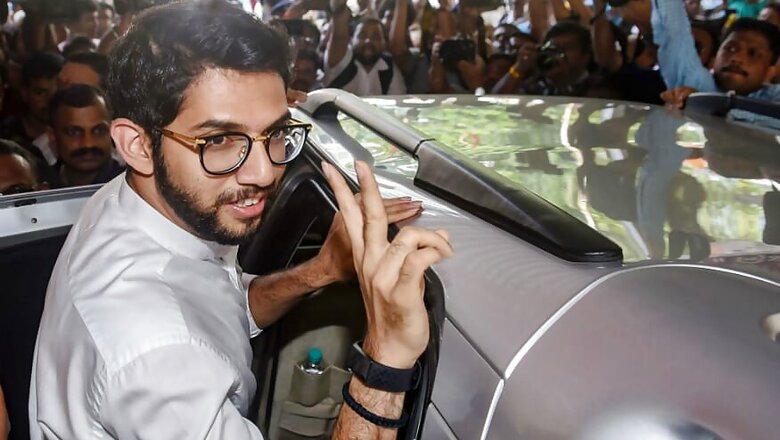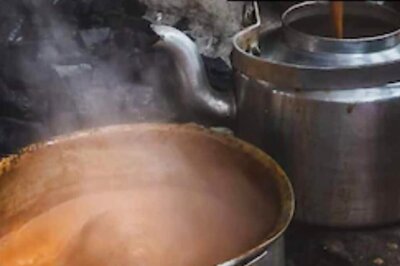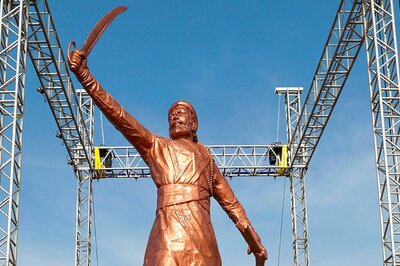
views
He is 29 years old, has a keen interest in international law and global affairs, is inspired by former British premier Tony Blair and new Labour, and flaunts his woke credentials by expanding his full name to include that of his mother.
Meet Aaditya Thackeray, Maharashtra’s new environment and tourism minister. After a successful maiden electoral run, the Yuva Sena chief and son of Shiv Sena president and Maharashtra chief minister Uddhav Thackeray and wife Rashmi, has been pitch-forked into a ministerial role.
The Maharashtra assembly polls and its aftermath have seen the Shiv Sena cross the rubicon in more ways than one. The party’s first family Thackerays, who have traditionally stayed out of government and power and preferred exercising control over it from outside traditional structures, plunged into electoral politics.
Aaditya became the first Thackeray to seek public office from the Worli assembly constituency in central Mumbai. A month of dramatic developments later, the Shiv Sena broke ties with erstwhile ally Bharatiya Janata Party (BJP) and joined hands with the Congress and Nationalist Congress Party (NCP), with Uddhav becoming chief minister of an alliance government.
In a surprise move, Aaditya was inducted into his father’s cabinet, making them the first such father-son duo to be part of a government in Maharashtra.
Like his induction into the dust-and-grime of electoral politics, which party insiders said was meant to keep leaders with soaring aspirations in check, Aaditya’s entry into the cabinet and choice of portfolios is also strategic.
Unlike ministries like home, urban development and co-operation, Aaditya’s departments of tourism and environment do not involve a heavy element of interaction with people at large. But they have a large footprint in terms of employment generation and social impact.
Visitors to the Thackeray residence of ‘Matoshri’ at Bandra in Mumbai during the early 1990s recall how Meenatai, wife of Shiv Sena supremo late Bal Thackeray, would deal with her husband’s irritation or anger while discussing things with visitors.
“Whenever Balasaheb lost his cool, Maasaheb (as she was called by the party faithful) would send some tea or eatables to break his link. If this did not work, she would put baby Aaditya on his lap. Aaditya was the favourite of his grandfather, who loved children. Aaditya would begin playing with Balasaheb’s rudraksha beads and the ruse would work,” they explain.
Much like the stabilising, calming influence that he had on his fire-and-brimstone grandfather, Aaditya — who has cemented his position in the Shiv Sena’s chain-of-command — is seen as one who can sober his party and give it a much-needed progressive makeover.
Even most hard-bitten Sainiks agree that the party, which was born out of the social and economic angst of the sons-of-soil, namely the Maharashtrians in Mumbai, needs to evolve as a pan-Maharashtra regional force.
Aaditya, with his elite, cosmopolitan education — at the Bombay Scottish school and later St Xavier’s college where he completed his bachelor’s in history before studying law — is seen as a change agent.
Many insiders in the Shiv Sena’s pyramidal aristocracy, where rules of entry are decided and enforced by the first family, say Aaditya is the antithesis of the typical Shiv Sainik. This is due to his soft-spoken style of speech, sophisticated mannerisms, interest in issues like international law and diplomacy, and environment.
However, like many well-laid plans, the devil lies in the details.
For one, despite the Shiv Sena claiming to be the alter-ego of the Marathi manoos, numbers of Marathi-speakers in Mumbai have continued to shrink under its watch compared to others like Hindi-speaking north Indians.
The fall in this core vote-base necessitates the need for the Shiv Sena, which has to contend with other rivals in this niche space like the rival Maharashtra Navnirman Sena (MNS), to create an auxiliary constituency to hold on to its control of the megapolis.
However, this outreach is easier said than done. Like after the state of Maharashtra was formed with Mumbai as its capital in 1960, the Marathi-speakers in the city are not in a majority but remain the largest minority, with its attendant insecurities.
The Shiv Sena feeds on this minority complex, using it to rally its forces, and any dilution of this position can be exploited by other political parties like the MNS, which is led by Uddhav’s estranged cousin Raj.
The Shiv Sena’s sharp turn to Hindutva in the late 1980s helped it expand in communally-sensitive parts of Maharashtra, and develop a base in sections of non-Maharashtrians in Mumbai.
But this came at a price in a fast post-modernising Mumbai, which was in the throes of a social and economic transition with the retreat of the manufacturing sector, which dispossessed predominantly Marathi labour.
In the 2009 Lok Sabha and assembly elections, the MNS harnessed this anger and caused the Shiv Sena- BJP’s defeat. The excessive focus on Mumbai has also prevented the Shiv Sena’s growth as a pan-Maharashtra regional force, like parties down south.
The strategy to expand its footprint seems to be on the cards considering Aaditya’s multi-lingual posters during his campaign in Worli, which however led to consternation in the party.
Despite its strong Maharashtrian presence, Worli has a cosmopolitan vote base and in 1951, saw the first north Indian MLA — Pandit Bhagirath Jha of the Socialist Party — being elected to the Bombay assembly, thus awakening the political aspirations of this social group.
Shiv Sena leaders say Aaditya was insistent on getting the tourism and environment portfolios.
Aaditya’s choice may be strategic. The tourism sector, despite its employment generation potential, has not received its due in the state government’s scheme of things.
Though Maharashtra has the scenic Western Ghats, a 720-km shoreline and beaches, rich archaeological sites, over 350 forts, hill stations and cutting-edge medical facilities, the tourism sector is unorganised.
Despite its employment and revenue generation potential, and the obvious trickle-down effect, the tourism sector has been languishing largely due to the lack of a policy push. And jobs for sons-of-soil has been the Shiv Sena’s war cry, since its birth in 1966.
According to the Economic Survey of Maharashtra 2018-19, at an all-India level, the state leads in foreign tourist visits, but stakeholders claim many of these visitors use Maharashtra as a transit spot. As serving and former officials in the tourism department admit, the state can do better when it comes to exploiting its potential.
Aaditya’s other portfolio, the environment department, will also necessitate some tight-rope walking when it comes to balancing the interests of industry with that of ecology.
The department was held by the Sena in the Fadnavis government but had little to show in terms of performance, except an ill-conceived and poorly-executed ban on disposable, single-use plastic that is observed more in violation. The ban, incidentally, was seen as Aaditya’s brainchild.
As political observers note, from organising self-defence camps for girls, speaking about overhauling education, and importing Humboldt Penguins from South Korea for the civic body-run zoo in Mumbai, Aaditya has launched a new brand of civil, aspirational politics. This is a fresh, scarcely occupied political space and akin to breaking new ground for the Shiv Sena, which is rooted in its politics of identity.
The tourism and environment portfolios will help expand this agenda to cover livelihood and ecological issues.
However, as a Congress politician says, Aaditya may have to negotiate his way through the party’s old guard, sections of which may resist change.
One of Aaditya’s college mates at the elite St Xavier’s college remembers him as a student who never put on any airs. He recalled how Aaditya would participate in the college fest ‘Malhar’ like any other volunteer, in a department which involved “heavy physical work.”
The question is, will Aaditya be successful in doing the heavy lifting to transform his party and governance at-large? Or will he prove to be yet another political dynast — they include around half of the Maharashtra council of ministers — who has made it to where he did by an accident of birth?
For Aaditya, the clock is ticking…
(Dhaval Kulkarni is a journalist and author of the book ‘The Cousins Thackeray: Uddhav, Raj and the shadow of their Senas,’ which is the first political biography of Uddhav and Raj Thackeray. Views are personal)




















Comments
0 comment